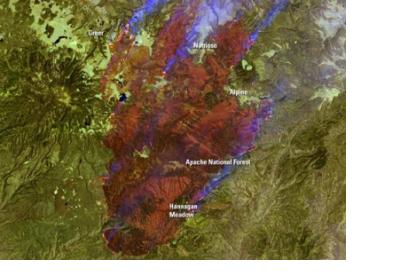Multiple firefighting agencies are using imagery -- provided by federally funded Landsat 5 and 7, Aqua and Terra satellites -- to combat wildfires that continue to blaze across Arizona.
The satellites capture images of the Earth's surface and then, using color enhancements, firefighters can identify different regions most susceptible to wildfire burning. In the images, burn scars are red, ongoing fires are bright red, vegetation is green, smoke is blue and bare ground is tan-colored.
When the locationBurning in the mountains of eastern Arizona near the border with New Mexico, the Wallow Fire has become the second largest fire in Arizona history.
CAPTIONUSGS of a wildfire is found, emergency managers can evacuate people in the path of the fire and pinpoint where water and firefighters need to go.
"In addition to providing information used to map the susceptibility of the forests to wildfires, the satellites can also provide emergency management agencies with data to gauge the extent of damage that was done over burnt areas," says Jim Irons, Landsat Data Continuity Mission (LDCM) project scientist.
Once a satellite has taken a photograph of the land after the wildfire has been contained, emergency managers can distinguish areas of land that have suffered extensive burning from those that remain intact. From this, officials can work to determine the cause of the wildfire and work towards preventing another one from happening. The Landsat Program, a joint venture between NASA and the U.S. Geological Survey, has recently helped emergency managers survey the damage caused by Hurricane Katrina, Mississippi River flooding, and a tornado that ripped through Springfield, Mass.

